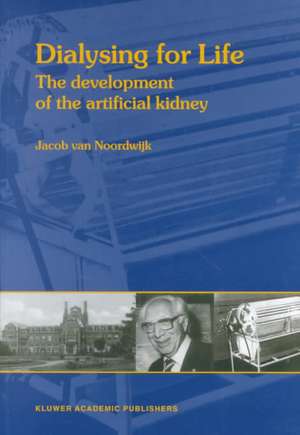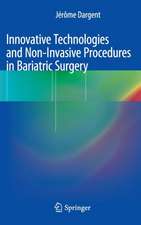Dialysing for Life: The Development of the Artificial Kidney
Editat de J. van Noordwijken Limba Engleză Paperback – 31 mar 2001
Ten years later doctor Willem Kolff saw a young man die in his ward in the University Hospital of Groningen due to renal failure. By that time two essential factors for an artificial kidney had become available: a drug to keep the blood from clotting outside of the body and an efficient dialysing membrane through which waste substances can pass from the blood into the dialysing fluid. Kolff succeeded in creating the rotating artificial kidney which he started using in the town hospital of Kampen in 1943. The rotation of this artificial kidney started a revolution that made it possible for thousands of kidney patients all over the world to keep on living - and sometimes to forget their disease for the time being. In addition it gave rise to the development of other artificial organs such as the heart-lung machine, the artificial heart and the artificial eye.
Doctor Jacob van Noordwijk, the author of this book, was Kolff's first assistant in the treatment of the first 15 patients. How Kolff succeeded in spite of all the limitations imposed by the German occupation of the Netherlands and in spite of the absence of antibiotics and other medical tools which are common nowadays makes a story which may sound incredible. Yet it did happen and visitors to the town of Kampen can still see the hospital building where it all took place.
| Toate formatele și edițiile | Preț | Express |
|---|---|---|
| Paperback (1) | 706.97 lei 6-8 săpt. | |
| SPRINGER NETHERLANDS – 31 mar 2001 | 706.97 lei 6-8 săpt. | |
| Hardback (1) | 713.54 lei 6-8 săpt. | |
| SPRINGER NETHERLANDS – 31 mar 2001 | 713.54 lei 6-8 săpt. |
Preț: 706.97 lei
Preț vechi: 744.18 lei
-5% Nou
Puncte Express: 1060
Preț estimativ în valută:
135.29€ • 146.91$ • 113.65£
135.29€ • 146.91$ • 113.65£
Carte tipărită la comandă
Livrare economică 22 aprilie-06 mai
Preluare comenzi: 021 569.72.76
Specificații
ISBN-13: 9780792368403
ISBN-10: 0792368401
Pagini: 114
Ilustrații: XII, 114 p.
Dimensiuni: 160 x 240 x 7 mm
Greutate: 0.2 kg
Ediția:Softcover reprint of the original 1st ed. 2001
Editura: SPRINGER NETHERLANDS
Colecția Springer
Locul publicării:Dordrecht, Netherlands
ISBN-10: 0792368401
Pagini: 114
Ilustrații: XII, 114 p.
Dimensiuni: 160 x 240 x 7 mm
Greutate: 0.2 kg
Ediția:Softcover reprint of the original 1st ed. 2001
Editura: SPRINGER NETHERLANDS
Colecția Springer
Locul publicării:Dordrecht, Netherlands
Public țintă
ResearchCuprins
1. The first dialysis in 1943.- 2. The prelude to the first dialysis in 1943.- 2.1 Why Dr Kolff wished to develop an artificial kidney.- 2.2 The search for a serviceable artificial kidney.- 2.3 The May days of 1940.- 2.4 To Kampen: the artificial kidney becomes a reality.- Notes.- 3. Step by step toward s a robust machine.- 3.1 Towards a continuous perfusion.- 3.2 The yield of the dialysis.- 3.3 Protection of erythrocytes during dialysis.- 4. In the meantime the war went on.- 4.1 All the things we did not have.- 5. The first series of 17 patients.- Notes.- 6. The second and third artificial kidney.- 6.1 Technical developments in the apparatus.- 6.2 The first kidney goes to The Hague.- 6.3 The third kidney goes to Amsterdam.- Notes.- 7. Hibernation of the kidney 1944–1945.- Notes.- 8. Recognition at home and abroad.- Notes.- 9. New ways of fighting uraemia.- 9.1 Peritoneal dialysis.- 9.2 Intestinal perfusion.- 9.3 Non-rotating artificial kidneys.- 9.4 Dietary reduction of protein breakdown.- Notes.- 10. Breathing with a kidney.- 11. The kidney in Canada and the USA.- 11.1 The artificial kidney in Montreal.- 11.2 The artificial kidney in London, Ontario.- 11.3 Sire of ‘kidney’ is Frankfurter: a leech also helped.- 11.4 Frustration in Cleveland.- 11.5 The twin-coil kidney, suitable for mass production.- 11.6 The artificial kidney in Boston.- 11.7 The Department of Artificial Organs at the University of Utah.- Notes.- 12. The place of the artificial kidney in present-day medicine — and how it was achieved.- 12.1 The accessibility of the patient’s blood vessels for repeated dialysis.- 12.2 Home dialysis.- 12.3 Renal transplantation.- 12.4 The 1972 legal regulation for reimbursement.- 12.5 The technical evolution of the artificial kidney.- 12.6 Does the clinicianmake an effective use of what is technically available?.- Notes.- 13. Renal dialysis in the Netherlands and in Europe.- 13.1 Renal dialysis in the Netherlands.- 13.2 Renal dialysis in Europe.- 13.3 Renal dialysis in the holidays.- Notes.- 14. On the shoulders of Kolff.- Notes.- 15. Has Kolff reached his goal?.- 16. A new life for old dialysers.








